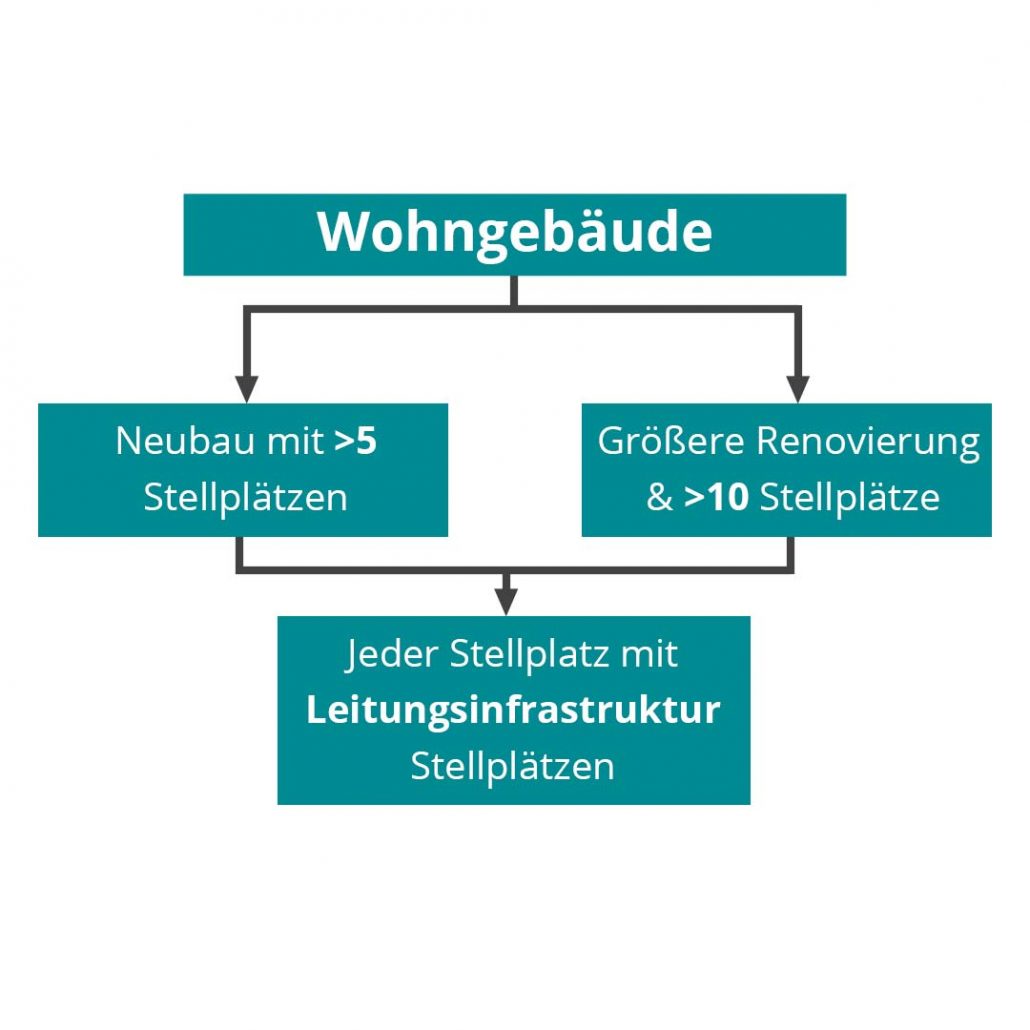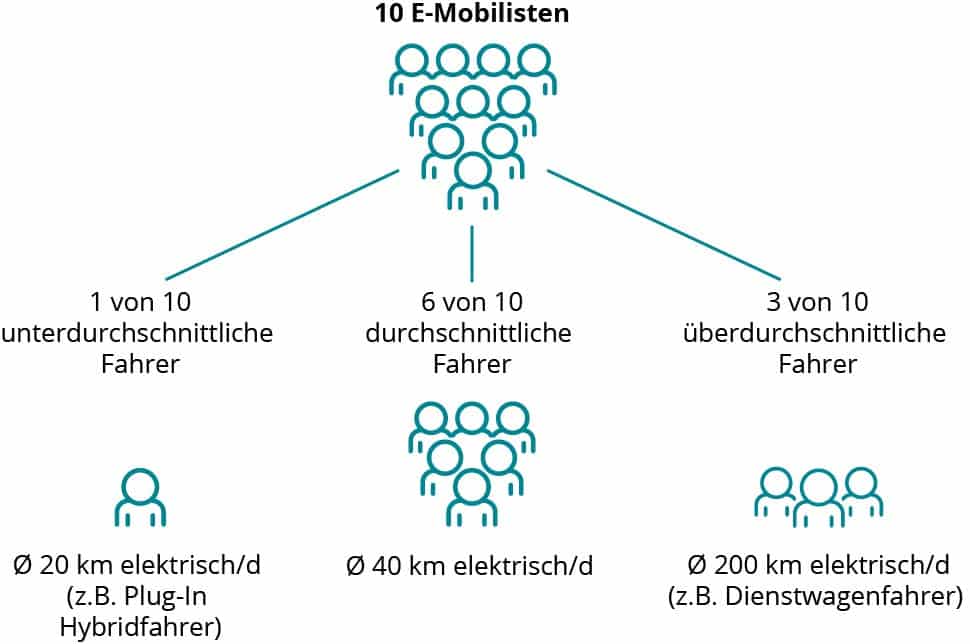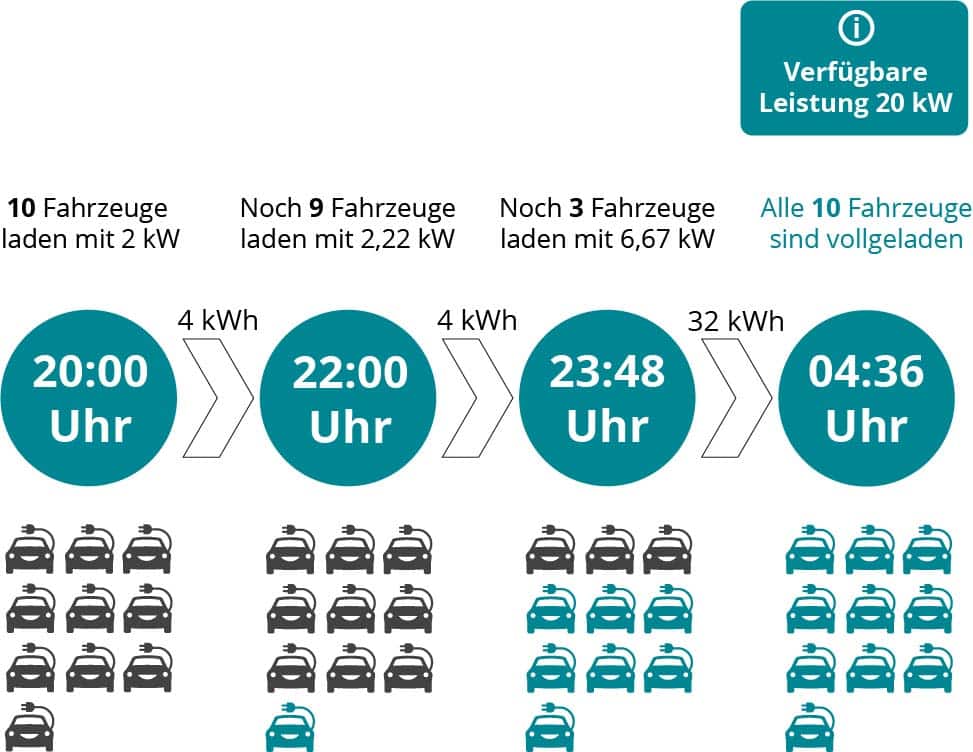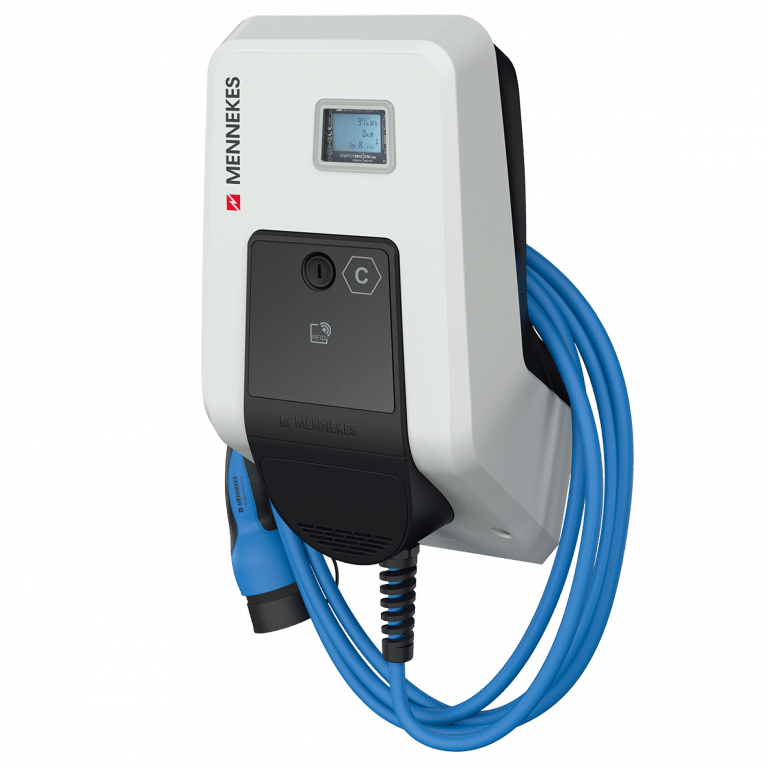Although the number of public charging points has increased enormously and more than 90,000 charging points are already publicly accessible in Germany (as of May 2023), the distances to the nearest charging station are often still long for many tenants and owners of apartment buildings. For these in particular, the installation of charging stations, e.g. in the underground car park, was previously almost impossible. But now tenants and owners can breathe a sigh of relief. The Act to Promote Electromobility and Modernize the Condominium Act and to Amend Regulations on Costs and Land Register Law (Condominium Modernization Act/WEMoG) came into force at the end of 2020.
Condominium owners, and due to changes and adjustments in tenancy law also tenants, can now demand permission to install charging devices! In addition to the innovations, we explain how owners and tenants can best proceed to assert their claim and to install a charging station as cost-effectively as possible.
If you are interested in more information about the Wallbox, we recommend our Wallbox Guide 2022!
Table of contents
1. entitlement to installation of a charging station due to law reform
The Residential Property Modernisation Act - WEMoG came into force on 1 December 2020 and provides for numerous innovations:
Basically, apartment owners and tenants are now entitled to the installation of a charging facility for e-cars, provided that the costs are borne by the beneficiary.
However, particularly in a homeowners' association (WEG), your co-owners are still allowed to have a say in how it is carried out. Other changes also include the fact that voting in a community of condominium owners is now also possible by video conference and with digital decision-making. In addition, it is now easier to pass resolutions on improvements to property that will sustainably save costs and bring apartments and houses up to modern standards, even against the resistance of individuals.
2. consideration of electromobility in new construction and renovations
The issue of electromobility must now also be taken into account in terms of new construction and major renovations.
To this end, the Building Electromobility Infrastructure Act (GEIG) was passed in the Bundestag on February 11, 2021. Among other things, it obliges owners of new buildings or major renovations of residential buildings with more than 5 (for new buildings) or 10 parking spaces (for renovations) to prepare the necessary wiring infrastructure for charging facilities. In the case of residential buildings, this means that in these cases each parking space must be prepared, for example, with empty conduits or cable trays for laying power and data cables. This is intended to enable easier and more cost-effective installation of charging points later on. The law has already been in force since March 2021.

The terms are defined in this way:
- A "major renovation" occurs when the work involves more than 25 percent of the surface area of the building envelope.
- The above-mentioned "line infrastructure" includes all line runs that are suitable for accommodating power and data cables from the required meter location to the parking space. These can be, for example, empty conduits, cable conduits or cable trays.
However, exceptions also apply: If the costs for charging and line infrastructures exceed 7 percent of the planned renovation, the requirements of the GEIG do not apply.
3. how flat owners and tenants should best proceed
3.1 Find fellow campaigners
3.2.1 Installation via flat meter
Installation of up to three single-phase circuits with max. 16A fuse protection is possible per meter in the so-called system-side connection space. One of these circuits can also be used for charging equipment. However, a maximum of 3.7 kW wallboxes can be connected via this and in any case an individual Coordination with a specialist electrical company necessary. Alternatively, an additional Circuit distributor after the apartment meter be installed. Via such a separate small distributor Per counterwallboxes over 3.7 kW can also be protected. The prerequisite for this procedure is that sufficient space is available for the installation of additional distributors and that an individual inspection and coordination with a specialist electrical company has taken place. However, when installing via the apartment meter, there are some Disadvantages. One of the main problems is that the House connection usually not designed for the additional power requirements of electric vehicles is. This means that the affected connection must be upgraded and additionally with a load management system must be secured to guarantee compliance with the limited available power. It is also problematic if there is not enough space for several sub-distributors and thus the solution cannot be implemented for everyone in the house. In principle, the installation of charging technology via the residential meter is not provided for and therefore usually requires adjustments to the meter location, for example the retrofitting of Overvoltage protection and circuit breakers. Lastly, when charging via the residential meter, no accrual of the charging current is possible, which is particularly disadvantageous for company car drivers who want to charge at home via the employer.3.2.2 Connecting wallboxes via separate meters
With this approach, a additional meter location, independent of the apartment meter, is provided for each planned charging point. For this must first and foremost enough space must be present and you must Estimate number of expected e-mobilists well can. This solution can be useful for smaller households with up to 10 parties, especially in outdoor areas. The separate meter locations can be supplied via an existing house connection, which is upgraded, or a new network connection. The latter is particularly suitable for the development of outdoor parking spaces, as no cables then have to be routed from the existing property to the outside. A clear advantage of a separate meter for the supply of charging infrastructure is that you can secure a favorable Car power tariff with reduced grid charges for example with SachsenEnergie to charge the e-vehicle can secure.3.2.3 Installation via a summator for electromobility
Lastly, there is the possibility of using a common totalizer to supply all charging points with power. This has the advantage that significantly less space required is and that the Number of wallboxes to be connected unlimited is. This solution is therefore particularly recommended for larger communities with many underground parking spaces. A system operator is required to operate the shared system, including power supply, load management and billing of the charging current at the wallboxes. SachsenEnergie offers a complete solution based on this model in your supply area.3.2.4 Suitable charging station for apartment building
One question must definitely be discussed in the community in the apartment building and then determined: Which charging technology should be installed?
Currently, the problem is that wallboxes from different manufacturers are often not compatible with each other due to different manufacturers' own load management systems. In order to keep the costs for upgrading the power for charging electric vehicles as low as possible, the use of a load management system is strongly recommended for two or three charging points or more . In many places, the responsible grid operator therefore even prescribes the use of load management.
For this reason, one thing is clear: communicative charging technology that can be integrated into a common load management system should be specified for future-proof equipping of a property from the very first prospective customer.
We recommend charging technology:
- with 11 kW per charging point,
- that is load-managing and communicative, and
- of a defined type and manufacturer
3.2.5 How much charging power is necessary?
In sharing with your home community, you should estimate how many e-mobilists can be expected in the next few yearsto request a sufficient upgrade of the grid connection (alternatively a separate connection for electromobility) from the grid operator. To avoid high additional costs, you should, under the condition of the use of a load management system, average 2 kW per pitch, apply. Your charging behavior with an e-vehicle will be very different from your previous "refueling" behavior: Instead of driving the e-car empty and only then visiting a filling station, you will come home, connect your vehicle to the charging facility every day and directly recharge the kilowatt hours consumed during the day. The best way to explain it is with an example. On average, people in Germany drive 15,000 km per year by car. This corresponds to a mileage of about 40 km per day. The average consumption of an e-vehicle can be assumed to be 20 kWh/100km. In an example property with 10 parking spaces and with 10 e-mobilists who travel different distances per day
If the available power of 20 kW (=2kW per E-parking space) were to be distributed over the charging E-vehicles over the course of the night in an idealised manner, this would be as follows:

When the e-drivers "come home", the power is still divided equally among all of them in the first step and 2 kW is available for charging the vehicles. However, as the night progresses, the vehicles are increasingly fully charged and more power is available to charge the remaining vehicles. At the end of the night, the batteries of all vehicles should generally be recharged.
3.3 Submitting an application
Were you able to find a common
- Concept
- the charging technology
- and the required charging power
define in consultation with your fellow members, it is now time to prepare a motion for the owner / WEG assembly.
Be sure to submit your request for the next owners' meeting so that it can be made in time and included on the agenda. Since the meeting usually takes place only once a year, tackle the project promptly.
Please keep in mind that possible cost offers from electrical companies or your network operator cost time and therefore need some lead time, if you already want to present figures and offers for decision making. Allow at least 3-6 months for the preparation of the offer.
3.4 Take a decision
According to the Home Ownership Act, the owners' meeting is not authorized to reject your application. It may only have a say in the implementation of the measure. It remains to be seen how the new law will be implemented in practice. Unfortunately, we do not yet have any empirical data on this.
3.5 Install
Please remember that the grid operator must be informed at the latest before the charging technology is installed. However, in most cases, the contact should have been made earlier, when applying for the additional power for charging electric vehicles.
If not, you cannot avoid it now at the latest, because the installation of charging technology greater than 11 kW per house connection (i.e. at the latest from the second resident who wants to install an 11 kW wallbox) must even obtain a permit from the network operator. This is normally taken care of by the commissioned electrical contractor.
3.6 Loading
Once the installation is done, you can finally charge your e-vehicle in your apartment building.
How the charging current is billed depends on the variant selected and agreed with the owners or property management.
Everything at a glance
- Search for comrades in arms
- Decide together on a charging solution
- Make the request
- Wait for the decision to ensure security
- Installation of the desired charging solutions
- Convenient charging from home






